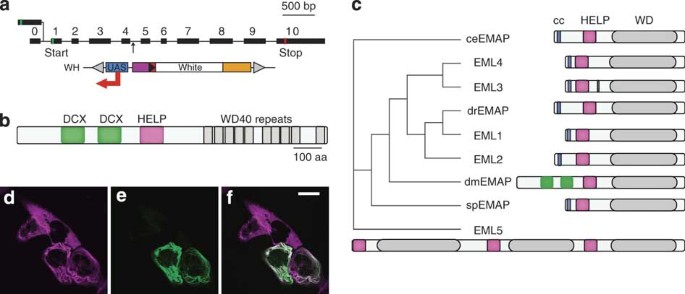
- Select a language for the TTS:
- UK English Female
- UK English Male
- US English Female
- US English Male
- Australian Female
- Australian Male
- Language selected: (auto detect) - EN
Play all audios:
Mechanoreceptors are sensory cells that transduce mechanical stimuli into electrical signals and mediate the perception of sound, touch and acceleration. Ciliated mechanoreceptors possess an
elaborate microtubule cytoskeleton that facilitates the coupling of external forces to the transduction apparatus. In a screen for genes preferentially expressed in Drosophila campaniform
mechanoreceptors, we identified DCX-EMAP, a unique member of the EMAP family (echinoderm–microtubule-associated proteins) that contains two doublecortin domains. DCX-EMAP localizes to the
tubular body in campaniform receptors and to the ciliary dilation in chordotonal mechanoreceptors in Johnston's organ, the fly's auditory organ. Adult flies carrying a piggyBac insertion in
the DCX-EMAP gene are uncoordinated and deaf and display loss of mechanosensory transduction and amplification. Electron microscopy of mutant sensilla reveals loss of electron-dense
materials within the microtubule cytoskeleton in the tubular body and ciliary dilation. Our results establish a catalogue of candidate genes for Drosophila mechanosensation and show that one
candidate, DCX-EMAP, is likely to be required for mechanosensory transduction and amplification.
Mechanotransduction is the process by which a mechanical force impinging on a cell produces an intracellular signal. This signal may function locally within the tissue to regulate cellular
motility, growth or differentiation1 or it may be transmitted to the central nervous system where it can lead to the perception of sound, touch or accelerations2. Mechanosensory cells often
contain elaborate cytoskeletal structures that provide a mechanical link from the external stimulus to the receptor module. A well-studied example of such a cytoskeletal linkage apparatus is
the hair bundle of hair cells, the receptor cells underlying the senses of hearing and balance in the vertebrate inner ear. Shearing of adjacent actin-filled stereocilia within the bundle
tenses extracellular links and leads to the opening of transduction channels located close to the apical tips of the stereocilia3.
In addition to actin-based mechanoreceptors such as hair cells, vertebrates and invertebrates contain microtubule-based sensory cells. Ciliated and non-ciliated sensory neurons in
Caenorhabditis elegans (C. elegans) mediate the response to touch4. Ciliated epithelial cells in the kidney detect fluid flow5, and ciliated receptor neurons in insect bristle receptors,
campaniform sensilla and chordotonal organs sense forces associated with touch, air flow, cuticle deformation, gravity and sound6. The transduction apparatus of auditory chordotonal receptor
neurons in the Drosophila antenna has been shown to be functionally equivalent to that of hair cells in that it can be described by serially arranged force-gated transduction channels,
adaptation motors and gating springs7. Correlates of auditory transducer gating and associated amplification have been identified in the fly's antennal mechanics, but proteins that are
required for transducer function have not been identified as yet.
In this study, we used DNA microarrays to identify genes that are specifically expressed in Drosophila campaniform receptors. Our reasoning was that such genes may include novel
mechanotransduction genes that have not been found in behavioural screens8,9. We identified a unique doublecortin-domain-containing echinoderm–microtubule-associated protein (DCX-EMAP,
CG42247) as a candidate for a mechanoreceptor-specific protein in flies. EMAP was first identified in sea urchins (Strongylocentrotus purpuratus)10. All EMAP family members share a common
conserved HELP domain (HELP; hydrophobic echinoderm–microtubule-associated-like protein) located at an acidic N-terminus and multiple C-terminal WD-40 domains11. Some EMAP homologues have a
role in cell division12,13,14,15,16, and others are expressed in neurons17, including the C. elegans homologue, which is expressed in muscles and mechanosensory cells18. In contrast to EMAP
homologues from other organisms, DCX-EMAP lacks the coiled-coil domain, but possesses two doublecortin (DCX) domains at its N-terminus. Doublecortin, mutations in the gene of which leads to
X-linked lissencephaly in humans, is a microtubule-associated protein found in migrating neurons19,20. Doublecortin is a microtubule-stabilizing protein that suppresses catastrophes (the
conversion of a growing microtubule to a shrinking one), stimulates microtubule nucleation and promotes the formation of 13-protofilament microtubules21,22. In this paper, we show that
DCX-EMAP is necessary for auditory transducer gating and amplification in Drosophila chordotonal receptor cells, as well as for the formation of microtubule-associated electron-dense
material within the sensory dendrites of campaniform and chordotonal neurons. Our findings identify DCX-EMAP as the first invertebrate protein that is essential for auditory transducer
function, and supports previous suggestions that the tubular body of campaniform receptors and the ciliary dilation of chordotonal receptors may be sites of mechanosensory transduction23,24.
We used DNA microarrays (Affymetrix) to identify genes of which the expression is increased in campaniform mechanosensilla of the fly's halteres. Halteres are vestigial hindwings that
function as gyroscopes25. They are composed of three segments: the large distal segment, the capitellum, functions as an inertial mass; and the proximal segments, the pedicel and scabellum,
contain arrays of campaniform sensilla that detect cuticular stresses generated when the fly accelerates and the capitellum moves relative to the body (Supplementary Fig S1). The proximal
segments contain 186 campaniform sensilla, whereas only 18 bristle receptors are housed by the capitellum26. Because, the capitellum is ∼10 times larger in volume than the pedicel and
scabellum combined, the proximal segments are ∼100-fold enriched in mechanosensory cells over the capitellum. The other cell types are primarily epithelial cells. We therefore expected that
tissue from the proximal segments would be ∼100-fold enriched in RNA expressed specifically in mechanosensilla (compared with the capitellum), but both tissues would have approximately the
same expression levels of epithelial genes. Because each mechanosensillum contains a mechanoreceptor cell and supporting cells, we reasoned that messages specifically expressed in
mechanoreceptors, including possible mechanotransduction genes, would be enriched in the proximal-segment tissue.
To compare the relative expression of genes in mechanoreceptor-rich and mechanoreceptor-poor tissues, we extracted RNA separately from the two proximal segments and the one distal segment of
50 halteres. RNA was also extracted from the thoracic ganglion to serve as a neuronal model tissue. Because the yield was low, RNA was amplified before hybridization with DNA microarrays
containing multiple 25-mer oligonucleotide probes for ∼13,000 different Drosophila genes. After scanning and processing of arrays to remove technical variances (see Supplementary
Information), differences between tissues were calculated from a linear model fit. In particular, a log2-ratio MPC comparing the expression levels in the two proximal segments (hereafter
called 'pedicel') with the capitellum was computed. Similarly, the log2-ratio MPN compares gene expression in the pedicel compared with that in the thoracic ganglion. Supplementary Data
contain the top 625 genes (our candidate gene list) ranked by the probability of a difference between pedicel and capitellum. This corresponds to 4.8% of the total genes (625 out of 13,000).
To determine whether our DNA microarray experiments identified genes overexpressed specifically in mechanosensory cells, we carried out several additional tests. First, we performed
quantitative real-time PCR (qRT–PCR) on 12 candidate genes, comparing pedicel and capitellum tissue. There was a highly statistically significant correlation between the log2 of the ratio of
qRT–PCR values and M values (t=4.7, P








:max_bytes(150000):strip_icc():focal(779x409:781x411)/dexter-2-10289077b0dc410f94fbc97743380f1f.jpg)